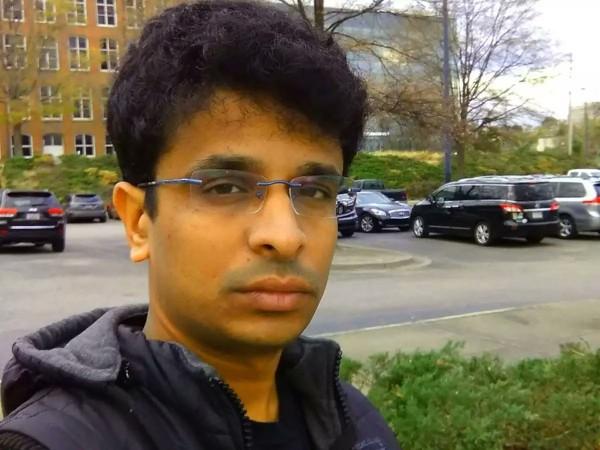Chandrayaan 2's Vikram lander, which crashed while attempting a soft landing on the moon, has been spotted. The US space agency has credited Chennai-based engineer Shanmuga Subramanian for the discovery.
The Indian Space Research Organisation (ISRO) had lost contact with the lander when it was 2.1 km away from the moon's surface. Following the communication snap, ISRO said in a statement: "This is Mission Control Centre. Vikram lander descent was as planned and normal performance was observed up to an altitude of 2.1 km. Subsequently, communication from lander to the ground stations was lost. Data is being analysed."

ISRO had later located the Vikram lander on the lunar surface but could not establish contact.
NASA had on September 27 released high-resolution of the lunar site where Chandrayaan 2 lander Vikram had attempted to soft-land. The US space agency had said it could not find the location of the lander.
Images taken by the Lunar Reconnaissance Orbiter Camera (LROC) showed that Vikram attempted a landing on September 7 between Simpelius N and Manzinus C craters. "Vikram had a hard landing and the precise location of the spacecraft in the lunar highlands has yet to be determined," said NASA.
The space agency had then invited people to compare the released image with images of the same area before the crash to find signs of the lander. Shanmuga Subramanian, a 33-year-old IT profession, came up with the first positive identification.
Who is Shanmuga Subramanian?
'Shan', as he identifies himself, is the eagle-eyed engineer who found Vikram moon lander. He said after the discovery that he took spotting the lander as a challenge when NASA could not.

He said in an email interview to IANS: "It was something challenging as even NASA can't find out so why can't we try out? And that's the thought that led me to search for Vikram lander."
Subramanian, who works as an information technology architect, in his spare time looked through the images taken by NASA's Lunar Reconnaissance Orbiter (LRO) camera on September 17 and spotted debris from Vikram.
Those images were taken when the light during moon's dusk was very harsh at the place where the moon lander crashed and the long shadows made the hunt for Vikram difficult, NASA and LRO said at that time.
LRO Project Scientist Noah Petro, to whom Subramanian emailed his finding, told IANS: "The story of this really amazing individual (who) found it, helped us find it, is really awesome."
Petro said: "This is the wonderful thing about our data. We released it for the world and anyone can use and he used it to make this discovery."

Subramanian suggested a crowd-sourced citizen scientist movement to help space organisations.
"LRO's data is a treasure trove. I would suggest students and others to help out NASA, ISRO and other space organisations by building a good database of LRO images with features like comparison etc.," Subramanian told IANS.
"Currently we have to compare it manually (and I) wish someone can do more on that, with NASA's scientists time-crunched for their Moon missions," he added.
Asked how he got interested, Subramanian said: "Space exploration is nothing new for me as I have been interested in space right from the scratch and watched ISRO's rocket launches closely even managed to capture some of it on my YouTube channel.
"I don't think Vikram lander would have made such impact on the minds of the Indian public if it had landed successfully (but) since it was lost there was a lot of discussions in public forums as well as on my Facebook regarding what malfunctioned etc.
"The crash landing of Vikram made more people interested in it and it also got eventually hooked me, which lead to me searching NASA's pic for nearly some 4-5 hours every night."
Subramanian spoke of the social media world of space enthusiasts where intense discussions were taking place about the mystery of Vikram and which helped his quest.
"Initially there was lot of false positives I got (that were) corrected by Twitterati and one of the tweets led to me a Reddit forum where they had the exact intended landing location and the path of Vikram," he said.
On being able to narrow down the area for his search, he said: "Though there was no data available about the path of Vikram lander, I eventually concluded it would have come from North Pole as one of the tweets from 'cgbassa' said Vikram has crossed the North Pole of the moon. And from ISRO's live images, I made out it would have stopped short of around 1 km from the landing spot so it eventually led to me searching around 2 sq km around the landing area."
That tweet was from CG Bassa, an astronomer with Astron, the Dutch radio astronomy institute.
"I searched around North of the landing spot as Vikram approached the landing spot only from the north and though there was lot of false positives, I found a tiny little dot and compared with previous LRO images upto last nine years which eventually confirmed it would be the debris. Then I reached out to NASA."
Petro said: "He emailed the team, myself and the head of the camera team with his finding and that was used to help identify the location."
The Arizona State University (ASU), where the LRO camera project work is done, said: "After receiving this tip the LROC team confirmed the identification by comparing before and after images" of the area.
After better pictures came from the LRO's pass over the area in October and on November 11, when the light conditions improved, the LRO camera team scoured the area surrounding the spot where Subramanian had spotted a debris and found the impact spot of Vikram's crash and other debris, the ASU said.
The impact site is located at 70.8810AoS, 22.7840AoE, at an elevation of 834 metres, it added.














